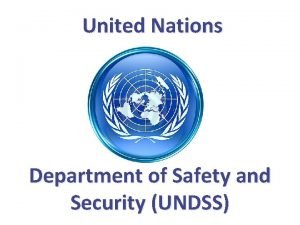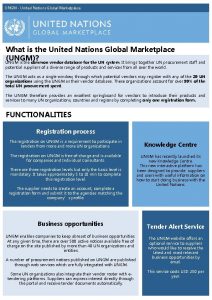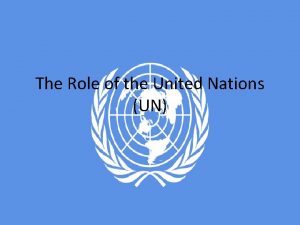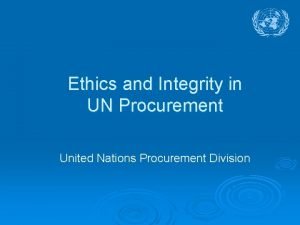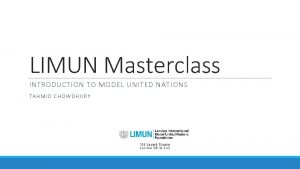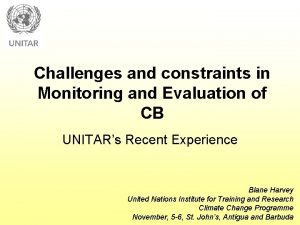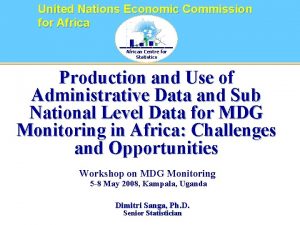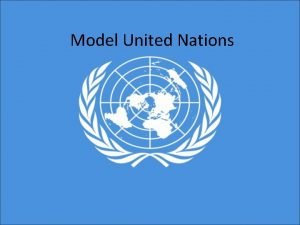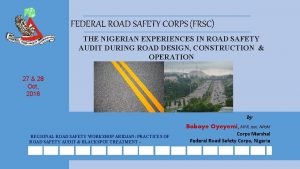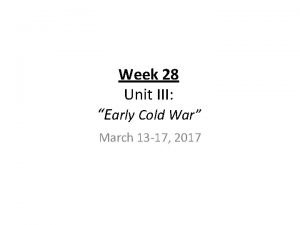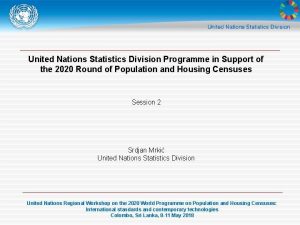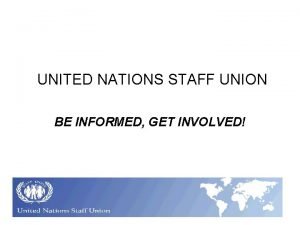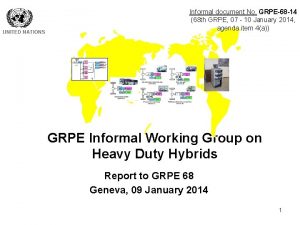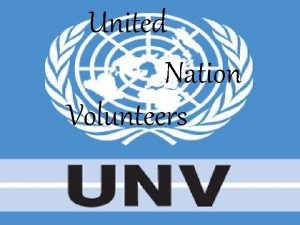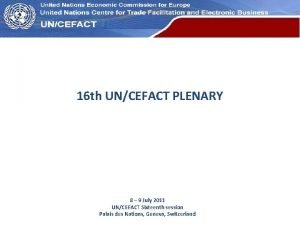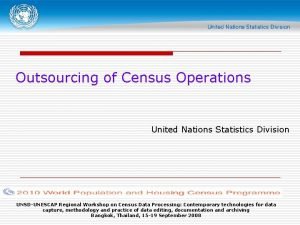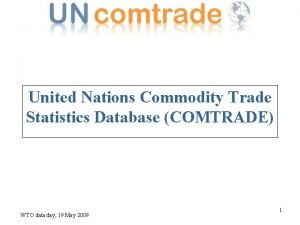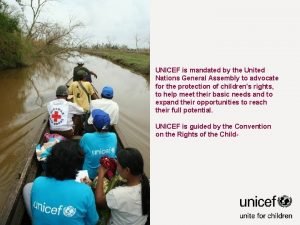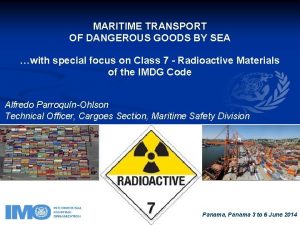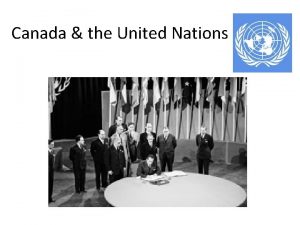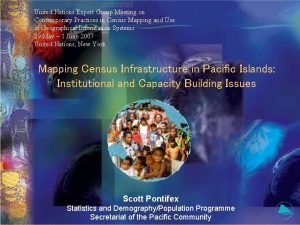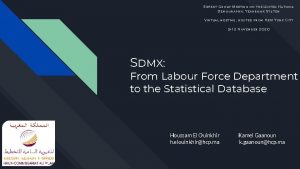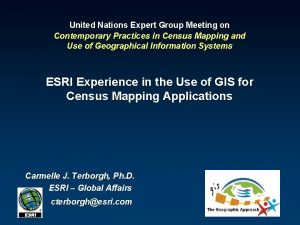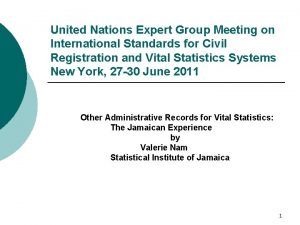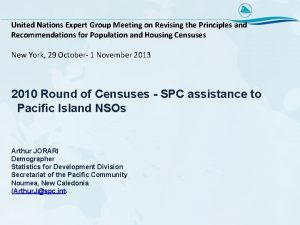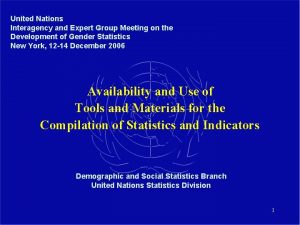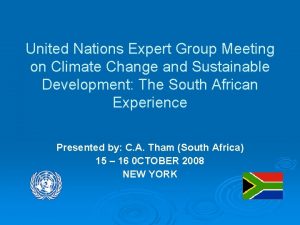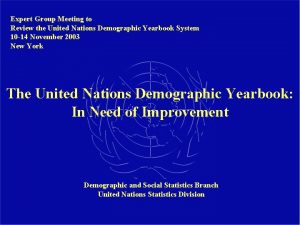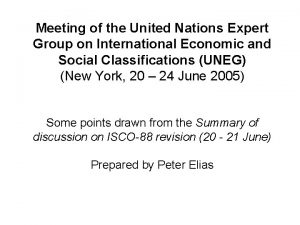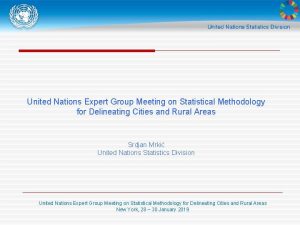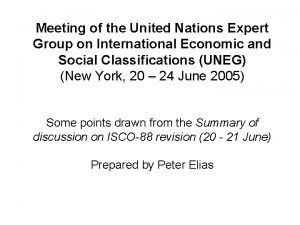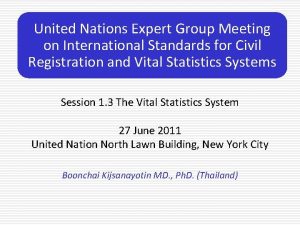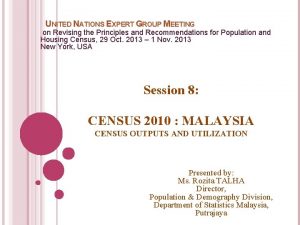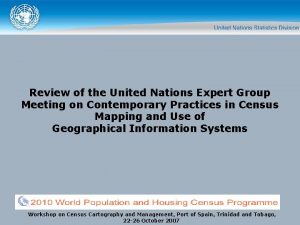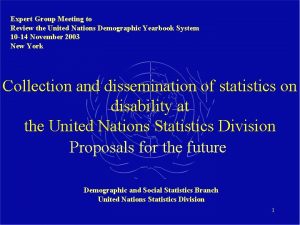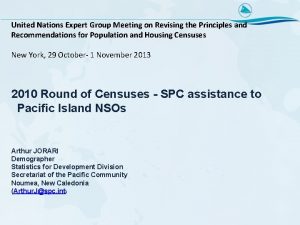United Nations Expert Group Meeting on on the




























- Slides: 28

United Nations Expert Group Meeting on on the 2010 World Programme on Population and Housing Censuses: International standards, contemporary technologies and regional cooperation. Census Geography in the Pacific Statistics and Demography/Population Programme Secretariat of the Pacific Community

Pacific Islands region - Background • • • CNMI Guam Palau Marshall Islands Federated States of Micronesia Papua New Guinea 22 member countries (15) and territories (7) 9. 3 million people over 34 million square km of ocean Unique Pacific challenges – – Distance Scale Scattered populations Challenging physical geography Nauru Kiribati Solomon Islands Tuvalu Tokelau Cook Wallis et Samoa Islands Futuna Am Fiji Samoa Vanuatu New Caledonia Niue French Polynesia Tonga Pitcairn Islands

Population and Housing Censuses, 2010 round 2005 Kiribati Palau 2006 Cook Islands Niue Samoa Tokelau Tonga 2007 2008 Wallis et Futuna Fiji 2009 2010 Marshall Islands Solomon Islands Vanuatu Am. Samoa CNMI FSM Guam PNG CNMI Guam Palau Marshall Islands Federated States of Micronesia Papua New Guinea Nauru Kiribati Solomon Islands Tuvalu Tokelau Cook Wallis et Samoa Islands Futuna Am Fiji Samoa Vanuatu New Caledonia Niue French Polynesia Tonga Pitcairn Islands

Province District Papua New Guinea Census Unit LLG

Group Island 1000 km Village 4 feet above sea level largest land area of any atoll in the world.

Past experience - What are the constraints? $ Cost and financing • PICTS experienced difficulties financing their census operations in 2000 round. Base maps did not exist • Some censuses in the past were planned and collected without a clear GIS capability in mind a lack of geographic identifiers. Digital base maps were not always available. Staff • Lack of skilled personel and loss of experienced staff (turnover) If there is continuous change of staff it impacts on the sustainability of census activities. Know how ? • • Traditionally census mapping was given low priority. Some NSOs countries relied heavily on assistance from their resident Lands and Surveys Dept or Mapping Agency. Collaboration with other government agencies has been challenging Time • Pre census mapping is usually done late in the planning phase of the census cycle (often adhoc and too late).

PICT National Statistics Office staff numbers Country Staff American Samoa 7 Marshall Islands 7 Samoa 27 Cook Islands 10 Nauru 3 Solomon Islands 22 FSM 19 New Caledonia 41 Tokelau 1 Fiji 80 Niue 3 Tonga 25 Northern Marianas 6 Tuvalu 5 Vanuatu 14 Wallis and Futuna 8 French Polynesia n. a. Guam 16 Palau 5 Kiribati 8 PNG 140

No digital maps used in EA definition No up to date maps existed in 1999 census Populations numbers in some of the urban EAs were difficult to manage resulting in unreasonable workloads for enumerators

Blacksands 835 Port Vila, Vanuatu Blacksands (peri-Urban) Enumeration Area In the 1999 Census this area was enumerated with : 943 Households : 4818 Population

Port Vila, Vanuatu Freshwota (peri-Urban) EA 840 In the 1999 Census this area had : 492 Households : 2715 Total Population 1997 2005

Problems with census mapping EA delineation: South Tarawa, Kiribati q 2005 EA’s in yellow q 2000 EA’s in green

• Most recent census November 2006 • No digital census block maps from 1996 were available only hard copy printed maps. • NSO staff worked with Ministry of Lands and Survey and Natural Resources on long term attachment (building capacity, improving relationship and less resource intensive on NSO) • Census block maps showed essential features (land parcels) and clear boundaries, as well as useful features such as churches gas station and roads that would help enumerators locate households and buildings shown on the map.

‘Old school’ vs ‘New School’ techniques • Automated cartography approach • Mapping of cadastral data (land parcels) which made up each census block • Manual digitization and plotting points (quite a manual labour intensive and time consuming process ) • However project moved from manual process to digital GIS by acquiring a scanner and satellite imagery for most of the Kingdom of Tonga • Establishment of revised Tonga Map Grid (TMG)


Remote sensing approach Aerial photography 1: 5, 000 and 1: 50, 000 scale Digital map layers (roads, Rivers, contour lines and major buildings) for whole of Samoa Digitisation of census map Sheets (878 EAs and approx 30, 000 HH).

Satellite Imagery and GPS Case : Republic of the Marshall Islands • 2006 the Economic Policy, Planning and Statistics Office conducted socioeconomic Community Survey on six Atolls to investigate basic living conditions and economic situation. • Used small hand held mobile Global Positioning System (GPS) units and high resolution satellite imagery • The team surveyed 1, 205 households across 6 Atolls with data collected on 9, 491 individuals (roughly 20% of the estimated population of the RMI. Majuro Survey Team being trained in GPS

Case : Republic of the Marshall Islands Pre Survey Mapping

Case : Republic of the Marshall Islands Data Collection Survey map provided to Ebeye Survey Team GPS coordinates, and selected households

Case : Republic of the Marshall Islands Post Survey mapping Children living adjacent to the current public dump in Majuro.

Pop. GIS for data dissemination and utilization • There was a need to simplify population data, and to make these data more accessible at levels of geography below simply national levels. • The SPC developed a customised software (Population GIS) for statisticians and planners, to improve the effectiveness of census (and other socio-economic) data dissemination and utilization • So far 10 national systems have been developed covering the Federated States of Micronesia, Kiribati, Samoa, Vanuatu, Solomon Islands, Cook Islands, Marshall Islands, Tuvalu, Tonga and Wallis et Futuna Two distinct groups of intended users • The producers of data and statistics (NSO) • The main users of this data (Planning)

Output: Population Atlas RMI

Future Outlook - Demand for small area data Solomon Islands 2 April Tsunami • In the pacific for some time there has been a growing demand for small area statistics below the national sub-national level . • A prime example is the need for village level population and housing data required for assessing, monitoring and managing disaster preparedness, given the Pacific islands' exposure to cyclones, earthquakes and other natural disasters. • More recently an earthquake measuring 8. 1 struck the Solomon Islands on 2 April creating a tsunami causing significant damage in the Solomon Islands. Information on displaced village population was needed in targeting emergency response work.

Future outlook – Dissemination: Internet mapping • Maps have become common place on the internet with the recent emergence of new “geobrowsing” technologies such as Google Earth, Google Maps and NASA World Wind. • Low -cost, easy-to-use alternatives to the more traditional heavyweight GIS applications. • SPC member country NSO’s also publish census mapping outputs via their national PRISM websites. • Internet based map servers being deployed in many Pacific Island countries will also make dissemination of census data to a wider audience also possible

Map Server in Pacific Island Countries • • To reduce vulnerability for Pacific Island States through availability of mapping information on the Internet. (SOPAC EU) Map server, presenting maps via the web, developed with Open. Source software operating in 14 PICTs

GPS used for collecting coordinates of individual houses The use of GPS for census taking has a distinct advantage in allowing the linking of census records to an actual physical location. In most PICTs, as is the case in many developing countries, no exact location database of dwellings exist for census project use, and a lack of street names and numbers mean no address lists are available. GPS also serves as a management tool: It is also expected to streamline the process for census workers and managers. here cross checking can be made and if necessary enumerators can be sent back to areas they have missed. In this situation handheld GPS and satellite imagery will greatly increase the accuracy of residence locations particularly in rural areas

GIS GPS/PDA INTEGRATION • PDA (Personal Device Assistant) A small, handheld lightweight field computer with GPS enabled • Simple navigation for enumerators using maps and Satellite Imagery • For updating EA boundaries • and also able to take GPS locations of Households • Automated questionnaire entry Household listing example Model Census Questionnaire example • Simple synchronization of field updates with laptop.

Critical success factors • Building an effective mapping capacity is very much tied to relationships built with other spatial data gathering agencies. (E. g. GIS user groups and Lands and Survey departments) • Develop a regional approach to training capacity building (sharing) or capacity- supplementation. Perhaps establish a regional census and survey cartographic capacity with a regional organization, like SPC. • Sharing of technology such as a stockpile of GPS units provided on loan to PICTs prior to census and survey undertakings). SOPAC allow use of A 0 scanner for countries to use and satellite imagery. • NSOs could benefit from the exchange of experience among countries through South collaboration and synergies created. • The participating countries and agencies would serve as resources to each other and form a repository of knowledge and implementing practices. E. g. – Census Knowledge Base • Censuses and surveys need to be properly planned, resourced and collected with a clear GIS capability in mind. Needs to become an ongoing process rather than implemented as an ad hoc task too late in the census cycle. • Political will and leadership is needed to make it work.

• Tank yu tumas Meataki ma’ata Malo aupito Ko raba Thank you Vinaka vakalevu Tangio tumas Sulang Faafetai tele lava Merci
 United nations
United nations United nation department of safety and security
United nation department of safety and security What is ungm
What is ungm Six main organs of the united nations
Six main organs of the united nations Role of united nations
Role of united nations Ethics and integrity at the united nations
Ethics and integrity at the united nations Introduction to model united nations
Introduction to model united nations Unitar united nations
Unitar united nations United nations zambia
United nations zambia United nations
United nations United nations
United nations What is mun
What is mun The agency sponsored by the united nations that compiles
The agency sponsored by the united nations that compiles Vision and mission of frsc
Vision and mission of frsc Christian saunders united nations
Christian saunders united nations Cold war
Cold war United nations statistics division
United nations statistics division Patricia nemeth united nations
Patricia nemeth united nations United nations
United nations Un introduction
Un introduction United nations
United nations United nations economic commission for europe
United nations economic commission for europe United nations flag
United nations flag United nations basic principles on the role of lawyers
United nations basic principles on the role of lawyers United nations statistics division
United nations statistics division Junior model united nations
Junior model united nations United nations commodity trade statistics database
United nations commodity trade statistics database Unicef is mandated by the united
Unicef is mandated by the united United nations convention on the carriage of goods by sea
United nations convention on the carriage of goods by sea

